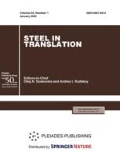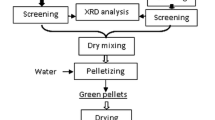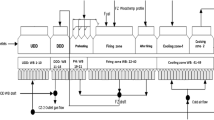Abstract
Currently, the most common fluxing additive to pellets is dolomite CaCO3 · MgCO3, in which the magnesium oxide content can form from 17 to 22%. If the magnesium oxide in pellets increases, then it is necessary to increase the dolomite dosage. Thus, the iron content decreases, which entails a decrease in yield ratio at subsequent processing. One of the fluxes containing magnesium is brucite. Compared with dolomite, magnesium oxide content in pure brucite is more than 3 times higher. The basis of Flumag M flux is brucite. The magnesium oxide content in it is not less than 55%. The paper presents a series of laboratory studies on the Flumag M flux dosage effects on the pelletizing ability of the charge and such properties of iron ore pellets as compressive, impact and abrasion strength. We have made the tests on raw and fired pellets with Flumag M flux. The comparative analysis of strength properties of the pellets obtained with the use of Flumag M and limestone was performed. The binder content, bentonite and magnetite concentrate, for all experiments remained unchanged. The experiment results indicate that Flumag M does not interfere with charge pelletizing ability. The strength of raw pellets for discharge and compression with Flumag M flux has small deviations from the pellets with the addition of limestone. Roasted pellets with the addition of Flumag M flux have higher strength than ones with limestone. The higher difference in strength properties is observed at the flux content of 2%.


Similar content being viewed by others
REFERENCES
Gimmel’farb, A.I., Nemenov, A.M., and Tarasov, B.E., Metallizatsiya i elektroplavka zhelezorudnogo syr’ya (Metallization and Electric Smelting of Iron Ore Raw Materials), Moscow: Metallurgiya, 1981.
Tulin, N.A., Kudryavtsev, V.S., Pchelkin, S.A., et al., Razvitie beskoksovoi metallurgii (Development of Non-Coke Metallurgy), Moscow: Metallurgiya, 1987.
Carvalho, R., Supply availability of DR grade pellet, Proc. 3rd World DRI & Pellet Congr., Abu Dhabi, 2015. https://www.metalbulletin.com/events/download.ashx/ document/speaker/7663/a0ID000000X0kBmMAJ/Presentation.
Vasil’ev, S.S. and Vasil’ev, E.N., Changes in strength of roasted non-fluxed pellets from rich Lebedinskii concentrate during recovery process, in Pryamoe poluchenie zheleza i poroshkovaya metallurgiya (Direct Production of Iron and Powder Metallurgy), Moscow: Metallurgiya, 1976, no. 2, p. 5.
Nobuhiko, T., Development of Iron-Making Technology: Nippon Steel Technical Report No. 101, Tokyo: Nippon Steel, 2012, pp. 79–88.
Alekseev, L.F., Gorbachev, V.A., Kudinov, D.Z., and Shavrin, S.V., Struktura i razrushenie okatyshei pri vosstanovlenii (Structure and Destruction of Pellets during Recovery), Moscow: Nauka, 1983.
Halt, J.A. and Kawatra, S.K., Review of organic binders for iron ore concentrate agglomeration, Miner. Metall. Process., 2014, vol. 31, no. 2, pp. 73–94.
Kovalev, D.A., Vanyukova, N.D., Ivashchenko, V.P., et al., Teoreticheskie osnovy proizvodstva okuskovannogo syr’ya (Theoretical Basics for Production of Agglomerates), Dnepropetrovsk: IMA-Press, 2011.
Chen, M., Zhang, W., Zhao, Z., et al., High temperature softening behaviors of iron blast furnace feeds and their correlations to the microstructures, Proc. 6th Int. Symp. on High-Temperature Metallurgical Processing, Chichester: Wiley, 2015, pp. 67–74.
Okrkr, S.I. and Onukwuli, O.D., Effect of basicity on metallurgical properties of pellets produced from Itakpe iron ore concentrates, Discovery Innovation, 1999, vol. 11, nos. 3–4, pp. 170–176.
Abzalov, V.M., Gorbachev, V.A., Evstyugin, S.N., et al., Fiziko-khimicheskie i teplotekhnicheskie osnovy proizvodstva zhelezorudnykh okatyshei (Physicochemical and Thermal Basics of Iron Ore Pellets Production), Leont’ev, L.I., Ed., Yekaterinburg: Molodezhn. Inf. Tsentr, 2015.
Kalenga, M.K. and Garbers-Craig, A.M., Investigation into how the magnesia, silica and alumina contents of iron ore sinter influence its mineralogy and properties, J. South. Afr. Inst. Min. Metall., 2010, vol. 10, pp. 447–456.
Poveromo, J.J., Grade pellet quality and supply, Proc. AISTech’2014 Annual Meeting, Indianapolis, Warrendale, PA: Assoc. Iron Steel Technol., 2015, pp. 751–762.
Forsmo, S.P.E., Samskog, P.O., and Bjorkman, M.T., A study on plasticity and compression strength in wet iron ore green pellets related to real process variations in raw material fineness, Powder Technol., 2008, vol. 181, no. 3, pp. 321–330.
Wang, Z., Chu, M., Chen, S., et al., Effects of B–Mg additive on metallurgical properties of oxidized pellets, Adv. Mater. Res., 2011, vols. 284–286, pp. 1232–1236.
Umadevi, T., Roy, A.K., and Prabhu, P.C., Influence of magnesia on iron ore sinter properties and productivity—use of dolomite and dunite, Steel Res. Int. J., 2009, vol. 80, no. 11, pp. 800–807.
Zborshchik, A.M., Teoreticheskie osnovy metallurgicheskogo proizvodstva (Theory of Metallurgical Production), Donetsk: Donsk. Nats. Tekh. Univ., 2008.
Timofeeva, A.S., Nikitchenko, T.V., and Kozhukhov, A.A., Role of magnesium oxide in formation of physical, chemical and metallurgical properties of iron ore pellets, Chern. Metall., Byull. Nauchno-Tekh. Ekon. Inf., 2018, no. 5 (1421), pp. 23–27.
GOST (State Standard) 12764–73: Iron Ores, Concentrates, Agglomerates and Pellets, Method for Determination of Moisture, Moscow: Izd. Standartov, 1974. http://docs.cntd.ru/document/1200024455. Accessed February 9, 2019.
GOST (State Standard) 24765–81: Method for the Determination of Compression Strength, Moscow: Izd. Standartov, 1981. http://docs.cntd.ru/document/gost-24765-81. Accessed February 9, 2019.
GOST (State Standard) 15137–77: Iron and Manganese Ores, Agglomerates and Pellets, Determination of Tumbler Strength, Moscow: Izd. Standartov, 1978. http://docs.cntd.ru/document/gost-15137-77. Accessed February 9, 2019.
Author information
Authors and Affiliations
Corresponding author
Additional information
Translated by A. Muravev
About this article
Cite this article
Kozhukhov, A.A., Timofeeva, A.S. & Nikitchenko, T.V. Effect of Flumag M Flux on Strength Properties of Iron Ore Pellets. Steel Transl. 50, 375–380 (2020). https://doi.org/10.3103/S0967091220060030
Received:
Revised:
Accepted:
Published:
Issue Date:
DOI: https://doi.org/10.3103/S0967091220060030




